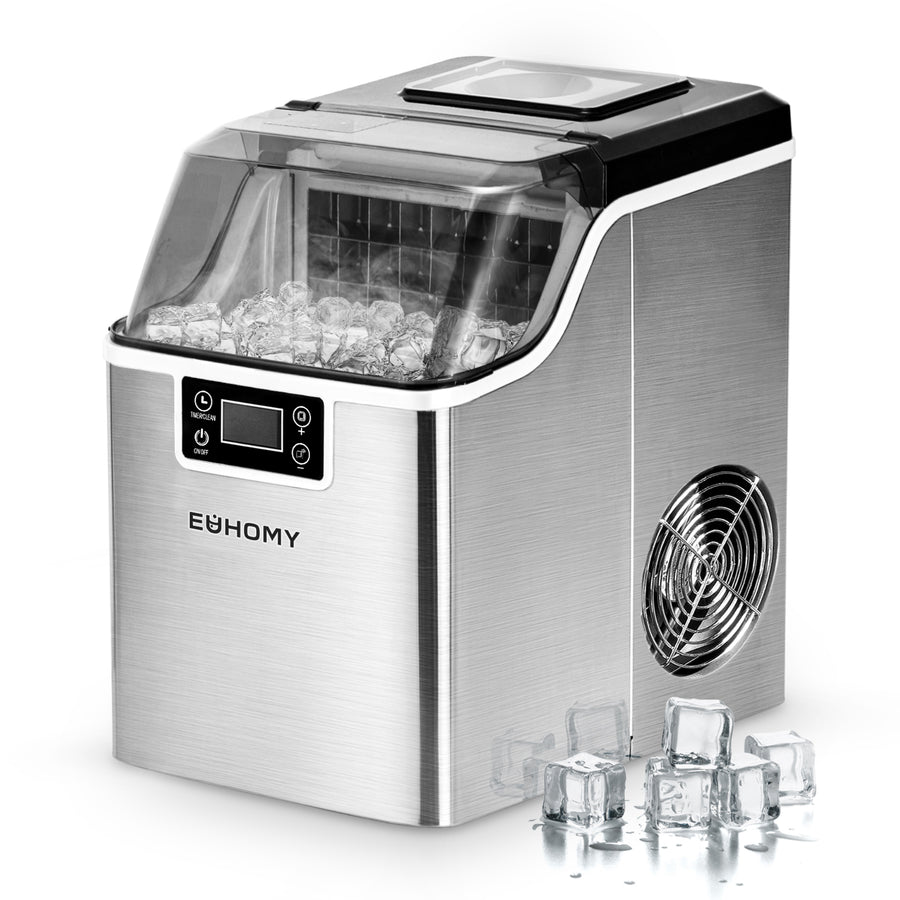VIDEOS
FAQs
How often do I need to clean my ice maker?
Depending on how frequently you use it. It is recommended that you clean it at least once a week. Regular cleaning prevents scale buildup, which can block the pump and cause the machine to malfunction.
How should I clean the machine?
Avoid using acidic solutions or lemon juice for daily cleaning cycles, as they can damage the nickel coating on the evaporator.
If there is scale on the bottom, soak the bottom water reservoir with a nickel-protected ice machine cleaner solution and clean water in a ratio of 1:5 for about 30 minutes, then drain the reservoir and rinse with clean water to remove the residual solution.
Draining the reservoir at least every three days is recommended. This helps maintain low water hardness, flush out impurities, and prevent scale buildup in the tank.
Why do my ice cubes stick together?
The cube ice machine makes ice in whole plates, which can be broken up with an ice scoop after falling off.
Why is the ice maker not made of stainless steel?
The machine is made of stainless steel but has a protective film to prevent scratches and fingerprints. If you prefer the stainless steel appearance, simply peel off the protective film.
Can I put milk and juice into the reservoir to make ice cubes?
Using liquids other than water to make ice cubes is not recommended. Our research has found that the particles in milk and beverages can easily block the pump and reduce its service life. Also, the protein in milk is prone to calcification, which chemically reacts with the PU water pipe inside the machine, causing it to break and making the product unable to continue working.
Why do my ice cubes melt easily?
The ice maker doesn't have an insulation function, so the ambient temperature will cause the ice to slowly melt. If not using the ice for a long time, store it in the refrigerator.
Why do the ice cubes I made smell of plastic?
Ice cubes themselves are tasteless. The first batch may have a strange taste and should be discarded. If the ice consistently smells of plastic, run several cleaning cycles with the Ice Maker Cleaning Agent to remove the odor. Finally, use drinking water to make ice.
Does it make ice automatically and stop when the ice bin is full?
Our ice maker is equipped with a sensor that automatically stops ice production when the ice bin is full.
Our ice maker is equipped with a sensor that automatically stops ice production when the ice bin is full.
Ice-making is too slow: Ice-making is slow at first use. Let it sit for 24 hours, then make ice several times at normal speed. Operate the ice maker in an environment below 90°F and use room temperature water for making ice.
Ice cubes are too small: In the first few cycles, the ice cubes might be smaller. Run several more cycles, and the ice will gradually return to its normal size.
Why are my ice cubes cloudy?
If used for the first time, the ice cubes may not be of the expected quality and can be discarded,
or this indicates that your water quality is turbid. It is recommended that only drinking water is used. If your water quality problem is serious, installing a water filtration system on your faucet is advisable.
Does the ice maker have internal water circulation?
The ice maker has internal water circulation. When ice melts, the water flows back into the reservoir to make new ice.
Why is my ice too thick and difficult to release from the tray?
This may happen if the ice-making time is too long or the room temperature is very low. We suggest unplugging the machine for 2 hours first, then plugging it back and adjusting the ice-making to “-6”.
To adjust ice thickness:
Use the “+” and “-” buttons on the control panel.
The number in the bottom-left corner of the display indicates the set ice-making time (default is 0).
Press “+” to increase the time in 1-minute increments for thicker ice or “-” to reduce it for thinner ice.
Troubleshooting

Manuals


Please contact customer service.
Contact Information
Business Inquiries: market@euhomy.com

